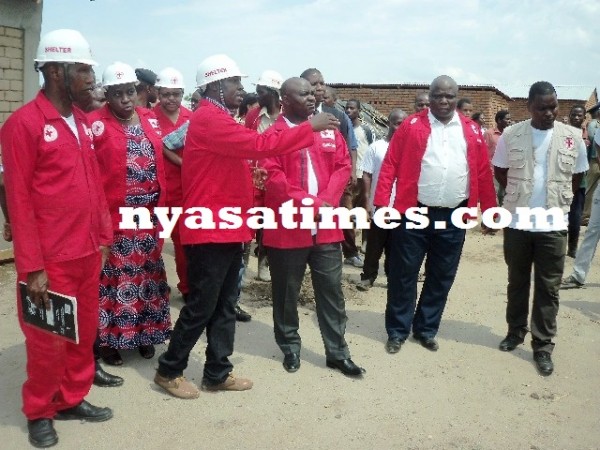![At the site where Redcross is constructing houses for vulnerable households of the floods survivors]()
Malawi government has launched the ‘National Recovery Disaster Framework’ which defines mechanisms for monitoring and management, clarify institutional roles and responsibilities and optimizes recovery investments across short-term humanitarian needs and medium to long term reconstruction, taking into account the principles of building-back-better and resilience.
[caption id="attachment_96329" align="alignright" width="600"]
![Mhango shakes hands with on eof the beneficiaries as others look on-Lapken Kapoto]()
Mhango shakes hands with on eof the beneficiaries as others look on-Lapken Kapoto[/caption]
[caption id="attachment_96328" align="alignright" width="600"]
![At the site where Redcross is constructing houses for vulnerable households of the floods survivors]()
At the site where Red Cross is constructing houses for vulnerable households of the floods survivors[/caption]
Minister of Information, Tourism and Civic Education, Jappie Mhango presided over the launch of the framework, followed the commemoration of the 2015 International Day for Disaster Reduction at Bodza Primary School in Traditional Authority Makhwira, Chikwawa district on Sunday.
The development of the National Disaster Recovery Framework (NDRF) was done with technical support from the Global Facility for Disaster Reduction and Recovery (GFDRR), United Nations and the World Bank, and financing by an African Caribbean Pacific-European Union (ACP-EU) grant.
Before the commemoration event on Sunday, Centre for Environmental Policy and Advocacy (CEPA) organized a panel discussion on Saturday at St Lawrence Girls’ Secondary School in Chikwawa where communities as well as technical experts from various institutions discussed issues to do with disasters especially the impact they caused and how best the impact would be minimized.
The panel discussion which was covered live on Zodiak Broadcasting Station as well as Chanco radios ended with an agreement from both parties that consolidation of indigenous and scientific knowledge can assist the country to reduce damages that occur during natural disasters.
In line with the theme under commemoration, the minister said science and indigenous knowledge in predicting weather were supposed to be used.
The minister also handed over a model house to one of the beneficiaries who relocated to upper land which is being constructed under Red Cross at Zing’ando village.
The houses being constructed are among the 200 houses the organization is also constructing in the districts of Nsanje, Phalombe and Blantyre.
The floods experienced by Malawi in early 2015 affected 1.1 million people in 17 districts, killing 106 people, while 172 people were declared missing.
The floods indirectly affected many more through secondary effects such as power outage, lack of clean water, and lack of market access and disruption of health and education services.
The government of Malawi through the Department of Disaster Management Affairs (DoDMA), and with technical support from the European Union, the United Nations and the World Bank, conducted a Post Disaster Needs Assessment (PDNA).
The PDNA estimated damage and losses at US$335 million and it estimated the cost of recovery and reconstruction needs at US$494 million.
The 2015 commemoration of the International Day for Disaster Reduction was done under the theme “Knowledge for life: Indigenous knowledge for disaster risk management.”

 Mhango shakes hands with on eof the beneficiaries as others look on-Lapken Kapoto[/caption]
[caption id="attachment_96328" align="alignright" width="600"]
Mhango shakes hands with on eof the beneficiaries as others look on-Lapken Kapoto[/caption]
[caption id="attachment_96328" align="alignright" width="600"] At the site where Red Cross is constructing houses for vulnerable households of the floods survivors[/caption]
Minister of Information, Tourism and Civic Education, Jappie Mhango presided over the launch of the framework, followed the commemoration of the 2015 International Day for Disaster Reduction at Bodza Primary School in Traditional Authority Makhwira, Chikwawa district on Sunday.
The development of the National Disaster Recovery Framework (NDRF) was done with technical support from the Global Facility for Disaster Reduction and Recovery (GFDRR), United Nations and the World Bank, and financing by an African Caribbean Pacific-European Union (ACP-EU) grant.
Before the commemoration event on Sunday, Centre for Environmental Policy and Advocacy (CEPA) organized a panel discussion on Saturday at St Lawrence Girls’ Secondary School in Chikwawa where communities as well as technical experts from various institutions discussed issues to do with disasters especially the impact they caused and how best the impact would be minimized.
The panel discussion which was covered live on Zodiak Broadcasting Station as well as Chanco radios ended with an agreement from both parties that consolidation of indigenous and scientific knowledge can assist the country to reduce damages that occur during natural disasters.
In line with the theme under commemoration, the minister said science and indigenous knowledge in predicting weather were supposed to be used.
The minister also handed over a model house to one of the beneficiaries who relocated to upper land which is being constructed under Red Cross at Zing’ando village.
The houses being constructed are among the 200 houses the organization is also constructing in the districts of Nsanje, Phalombe and Blantyre.
The floods experienced by Malawi in early 2015 affected 1.1 million people in 17 districts, killing 106 people, while 172 people were declared missing.
The floods indirectly affected many more through secondary effects such as power outage, lack of clean water, and lack of market access and disruption of health and education services.
The government of Malawi through the Department of Disaster Management Affairs (DoDMA), and with technical support from the European Union, the United Nations and the World Bank, conducted a Post Disaster Needs Assessment (PDNA).
The PDNA estimated damage and losses at US$335 million and it estimated the cost of recovery and reconstruction needs at US$494 million.
The 2015 commemoration of the International Day for Disaster Reduction was done under the theme “Knowledge for life: Indigenous knowledge for disaster risk management.”
At the site where Red Cross is constructing houses for vulnerable households of the floods survivors[/caption]
Minister of Information, Tourism and Civic Education, Jappie Mhango presided over the launch of the framework, followed the commemoration of the 2015 International Day for Disaster Reduction at Bodza Primary School in Traditional Authority Makhwira, Chikwawa district on Sunday.
The development of the National Disaster Recovery Framework (NDRF) was done with technical support from the Global Facility for Disaster Reduction and Recovery (GFDRR), United Nations and the World Bank, and financing by an African Caribbean Pacific-European Union (ACP-EU) grant.
Before the commemoration event on Sunday, Centre for Environmental Policy and Advocacy (CEPA) organized a panel discussion on Saturday at St Lawrence Girls’ Secondary School in Chikwawa where communities as well as technical experts from various institutions discussed issues to do with disasters especially the impact they caused and how best the impact would be minimized.
The panel discussion which was covered live on Zodiak Broadcasting Station as well as Chanco radios ended with an agreement from both parties that consolidation of indigenous and scientific knowledge can assist the country to reduce damages that occur during natural disasters.
In line with the theme under commemoration, the minister said science and indigenous knowledge in predicting weather were supposed to be used.
The minister also handed over a model house to one of the beneficiaries who relocated to upper land which is being constructed under Red Cross at Zing’ando village.
The houses being constructed are among the 200 houses the organization is also constructing in the districts of Nsanje, Phalombe and Blantyre.
The floods experienced by Malawi in early 2015 affected 1.1 million people in 17 districts, killing 106 people, while 172 people were declared missing.
The floods indirectly affected many more through secondary effects such as power outage, lack of clean water, and lack of market access and disruption of health and education services.
The government of Malawi through the Department of Disaster Management Affairs (DoDMA), and with technical support from the European Union, the United Nations and the World Bank, conducted a Post Disaster Needs Assessment (PDNA).
The PDNA estimated damage and losses at US$335 million and it estimated the cost of recovery and reconstruction needs at US$494 million.
The 2015 commemoration of the International Day for Disaster Reduction was done under the theme “Knowledge for life: Indigenous knowledge for disaster risk management.”